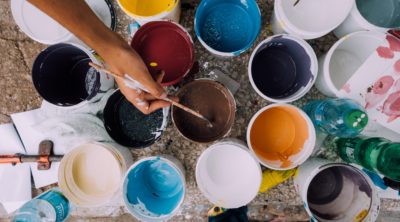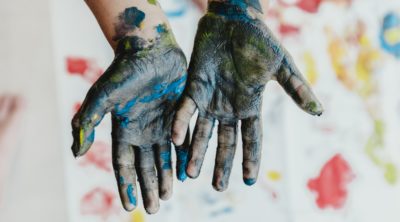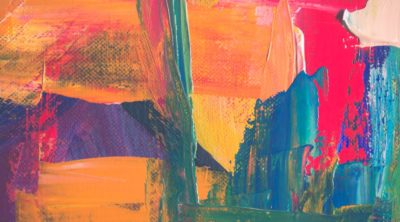
The Mexican renaissance period saw the emergence of many artists who gave Mexican art a new identity. Museums began displaying folk arts. Mexican art of the time comprised pottery, sculpture, woodwork and painting. Early works of Mexican artists had Spanish influences. They evolved over time and so did their works of art.
Mexico has always been blessed with great artists who have devoted their lives to the pursuit of art and made Mexican art popular. After the Mexican Revolution a new generation of Mexican artists emerged. These artists set the stage for new trends in art. Their large-scale murals depicting human life and carrying social messages gave an entirely new dimension to Mexican art.
Till the Spanish ruled Mexico, their art too bore influences of the Spanish culture and traditions. After independence, their works of art still had a European flavor, but they also portrayed elements of the Mexican culture. Let’s take a look at some of the most famous Mexican artists who made a huge difference to how the world perceived the art of Mexico.
Diego Rivera
He was born on December 8, 1886 in Mexico. At the age of ten, he began studying art at the Academy of San Carlos in Mexico City. Teodoro A. Dehesa Méndez, the governor of the State of Veracruz, sponsored Rivera’s study in Europe. Deriving inspiration from Paul Cezanne’s paintings, Rivera became a part of the Post-Impressionism movement in 1917. He married Frida Kahlo in August 1929, four months after which, he was contracted to paint murals in the Palace of Cortez in Cuernavaca. Later in 1930, he painted a mural for the Stock Exchange and a fresco for the California School of Fine Art. Rivera traveled to many parts of the world and displayed his works of art. He won international acclaim for his paintings that were exhibited in numerous exhibitions the world over. Apart from being a painter and muralist, he was also an active communist. He died on November 24, 1957 at the age of seventy.
Jose Clemente Orozco
A social realist painter and lithographer Jose Clemente Orozco was born on November 23, 1883. He led the Mexican Mural Renaissance along with Diego Rivera. He, with Siqueiros and Rivera, formed the trio known by the name ‘Big Three’ muralists. ‘The Epic of American Civilization’ is one of his most famed murals. His artistic works were often, depictions of human suffering, although less realistic. His death on September 7, 1949 meant the loss of one of the most famous Mexican artists. The Carrillo Gil Museum in Mexico City and the Orozco Workshop-Museum in Guadalajara display his works of art.
David Alfaro Siqueiros
Born on December 29, 1896, Siqueiros was a muralist and a Stalinist. Art ran in his mother’s family who came from a family of poets, actors and musicians. He lost his mother at an early age of two. He received training in art from the San Carlos Academy. His works of art depicted the struggle of man’s daily life. He portrayed revolutionaries. He developed an art form that became universal and earned him recognition. He was instrumental in establishing the Mexican Mural Renaissance that was the result of his large murals in fresco. His art represented his times and was rooted in the Mexican Revolution and the Spanish Civil War. He was the receiver of the Lenin Peace Prize in 1966. He was one of “the big three” Mexican muralists. He died on January 6, 1974. He is remembered for his famous works such as ‘Portrait of the Bourgeoisie’ and ‘The March of Humanity’ among others.
Frida Kahlo
She was born on July 6, 1907 in Coyoacan, then a small town on the outskirts of Mexico City. At the early age of six, polio left her right leg thinner than the left one. As a child, she suffered from many injuries and accidents. After a major accident in 1925, due to which she had to undergo thirty-five surgeries, she decided to take up painting as a full-fledged career. The famous Mexican painter Diego Rivera, her guide and adviser became her life partner in 1929. They did not have a happy marriage. Life brought her physical and psychological trauma. Her paintings also reflect bitter truths of her life. Self-portraits form a significant part of her paintings. She passed away on July 13, 1954, leaving behind a message that said, “I hope the exit is joyful – and I hope never to return – Frida”.
Arnold Belkin
‘The Canadian Son of Mexican Muralism’, as he was often called, was born on December 9, 1930. During his years at Vancouver School of Art, he became deeply interested in Muralism. He was a student of La Esmeralda Art School and the INBA School for Painting and Sculpture. By 1950, he had created his first mural. Belkin portrayed the Mexican culture, their festivals and death. He made friends with David Alfaro Siqueiros in the early 1950s. He held his first individual exhibition in 1952. In 1963, he was one of the four artists who represented Mexico at the International Award Exhibition in New York. Siqueiros, Icaza, and Tamayo were the other three. ‘The Sephardic Migration in Mexico’ was one of his famous paintings, preserved at the Monte Sinai Social Center in Mexico City. Belkin used oil paints, acrylic colors and various other media of painting. Most of his paintings were themed on history. He was a dynamic and an innovative Mexican artist. He passed away in 1992.
Rufino Tamayo
Born in August 1899, Tamayo was a figurative abstract painter. Art movements like Cubism, Impressionism and Fauvism influenced his artistic creations. He was against following the political trend that his contemporaries did, because of which he was perceived as a traitor to the political cause. He had to leave Mexico City and shift his base to New York. His major graphic works were created between 1925 and 1991. His graphic art developed into a new genre called Mixografia. It is a technique that renders a 3-d texture to prints. This art form was what Rufino Tamayo was best known for. He also painted murals. He died of a heart attack in 1991.
Joaquín Clausell
He was Mexico’s best-known impressionist painter. He studied law, then became a journalist. Influenced by the works of artists like Claude Monet, he started pursuing painting. What distinguishes him is his search of new areas to portray the Mexican landscape. He has created many seascapes too. In the early 20th century, he had earned reputation as an Impressionist. He was the first artist to bring impressionism to Mexico. He died in November 1935.
Rodolfo Escalera
He was a Mexican-American artist, best known for the collectible plates he created for the 1984 Summer Olympics. He had inherited skills in painting from his father and grandfather who were also brilliant artists. Even as a child, he was a very good painter. He worked in an architectural firm for a brief period, then in an advertising firm, after which he switched to the plate industry. After entering the plate collector business in 1980, his works started gaining popularity. This made him apply as an official licensee for the 1984 Summer Olympics, where he was given the opportunity to create paintings depicting Olympic sports. In 1986, he got the opportunity to create a collectible plate for the Mexico-hosted World cup. Throughout life, he pursued his passion for art. He wanted to be remembered as a part of Mexico and that he is.
Pedro Coronel
Born on March 25, 1923, he grew up to become one of the most famous Mexican artists. He learned painting and sculpture at La Esmeralda National School of Painting, Sculpture and Engraving in Mexico City. Colors of the pre-Hispanic culture are seen in his works. He was an abstract painter, sculptor and also a draftsman and engraver. After his first exhibition in Mexico City, his works were displayed in many museums around the world. He was honored with the National Prize for Arts and Sciences in 1984. He passed away in 1985.
Vlady Kibalchich Russakov
He was a Russian-Mexican painter known by the name ‘Vlady’. He was also a muralist and printmaker. Starting as an unsuccessful muralist, he toured places to learn the art. He went on to lead the contemporary art movement in Mexico. His style of painting can be described as near-abstract. During the 1960s, it became minimalist. His artworks bore influences of the Mexican muralism and French surrealism. He painted murals of the Miguel Lerdo de Tejada library of the Secretariat of the Treasury of Mexico. He died of cancer in 2005.
Manuel Álvarez Bravo
He belonged to a family of artists. His grandfather was a photographer and his father a follower of photography, painting and literature. Around 1925, when he was 23, he began professional photography. His works had a tinge of surrealism. He captured images of objects in ways that they looked lively and seemed to possess human qualities. He is known to have influenced the Mexican and Latin-American photography of his time.
Rodolfo Morales
Born on May 8, 1925, Rodolfo Morales was a native of Oaxaca, a city in Mexico. He was fond of drawing since childhood. He studied art at the Academy of San Carlos in Mexico City. For a very long period, he taught art. It was in 1975 that he got an opportunity to hold his first solo exhibition. Here, Rufino Tamayo saw his paintings. He played a major role in making Rodolfo’s work known to critics and art lovers. Soon his works achieved fame. He became known for surrealism and use of bright colors in his canvases and collages. Women (Mexican women in villages) and memories (nostalgia) were subjects of his works and his paintings always had a dreamy feel. Around 1985, he started working towards restoring historical buildings. With the combined efforts of him, Tamayo and Francisco Toledo, Oaxaca became a center of contemporary art and attracted tourists. Morales suffered from pancreatic cancer and died on January 30, 2001.
Robert Graham
Born in 1938 in Mexico, Robert Graham went on to become a famous sculptor. He lost his father at a tender age of 6. He studied art at the San Francisco Art Institute in California. He had solo exhibitions in many prominent museums. The first one was in the Dallas Museum of Art. He sculpted the ceremonial gateway for the Los Angeles Memorial Coliseum and the commemorative silver dollar for the 1984 Olympics. His bronze monuments depicting the human figure can be seen across America. He was inducted to the California Hall of Fame. He died in December 2008.
Gilberto Aceves Navarro
“I’m partying and playful, but also very disciplined and serious”, is how this great Mexican artist describes himself. Born on September 24, 1931, he rose to be one of the most recognized artists of Mexico, known for his versatility, wit and humor. He has had over thirty solo exhibitions in different countries and his paintings are displayed in many renowned museums. He has received the National Prize of Science and Arts. He is a dedicated artist and a teacher who has taught art to many budding artists in the country. He is known for his colorful paintings which include works in oil, watercolor and his graphic works. Apart from painting, he is passionate about classical opera.
Carlos Amorales
He lives in the Mexico City. His work spans different fields allied to art, like video animation, sculpture and drawing. His earlier works depicted masked wrestlers performing in rings. It is said that the masks were a visual representation of the artist’s own face. He has had many exhibitions and his works feature in private collections and art galleries. His works majorly portray contemporary Mexican culture.
Miguel Condé
Born in 1939, in Pittsburgh, Pennsylvania, he is the son of a Mexican father and an American mother. He is a Mexican figurative painter and also a draftsman and printmaker. He has worked as an instructor of drawing and mixed media. His first exhibition was held in Spain in 1974. Many museums represent his work and he has been honored with many awards for his contribution to art.
Francisco Toledo
Born in 1939, in Pittsburgh, Pennsylvania, he is the son of a Mexican father and an American mother. He is a Mexican figurative painter and also a draftsman and printmaker. He has worked as an instructor of drawing and mixed media. His first exhibition was held in Spain in 1974. Many museums represent his work and he has been honored with many awards for his contribution to art.
Other Famous Names
- Salvador Corona
- Rubén Ortiz Torres
- Mauricio Toussaint
- Rafael Vargas-Suarez
- Juan Soriano
- Luis Barragán (architect)
- Feliciano Béjar
- Vicente Rojo
- Abraham Ángel
- Gunther Gerszo
- Olga Costa
- Federico Cantú
These artists have played a big role in introducing Mexican art to the world. With their unique styles of depicting Mexican culture and values, they have given Mexican art, an identity of its own. Art lovers around the world remember these artists and their country for their contribution to art.






